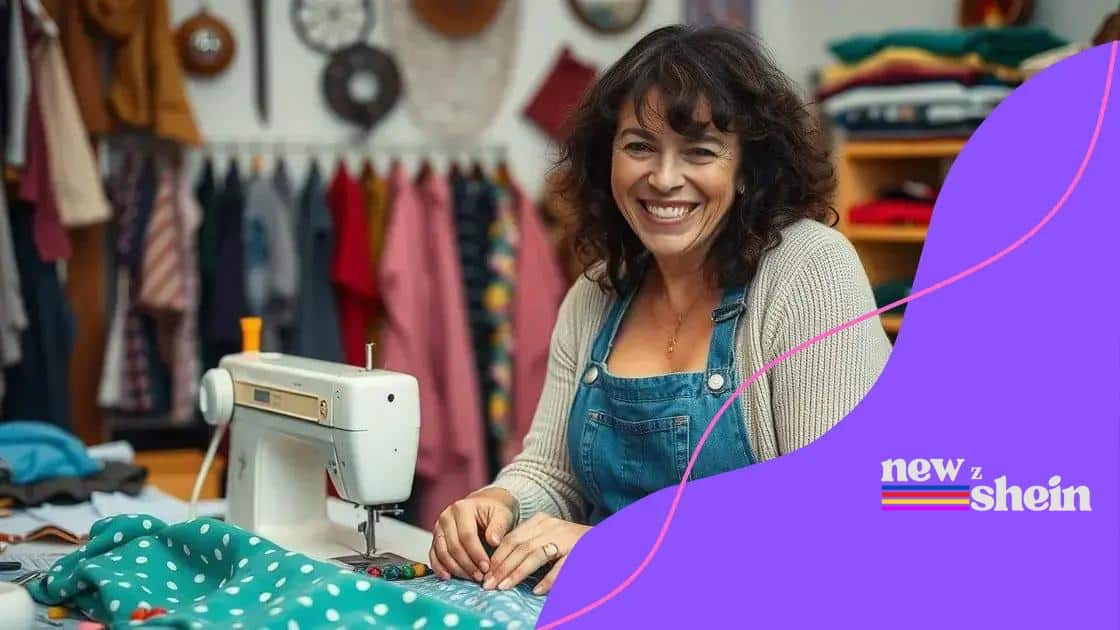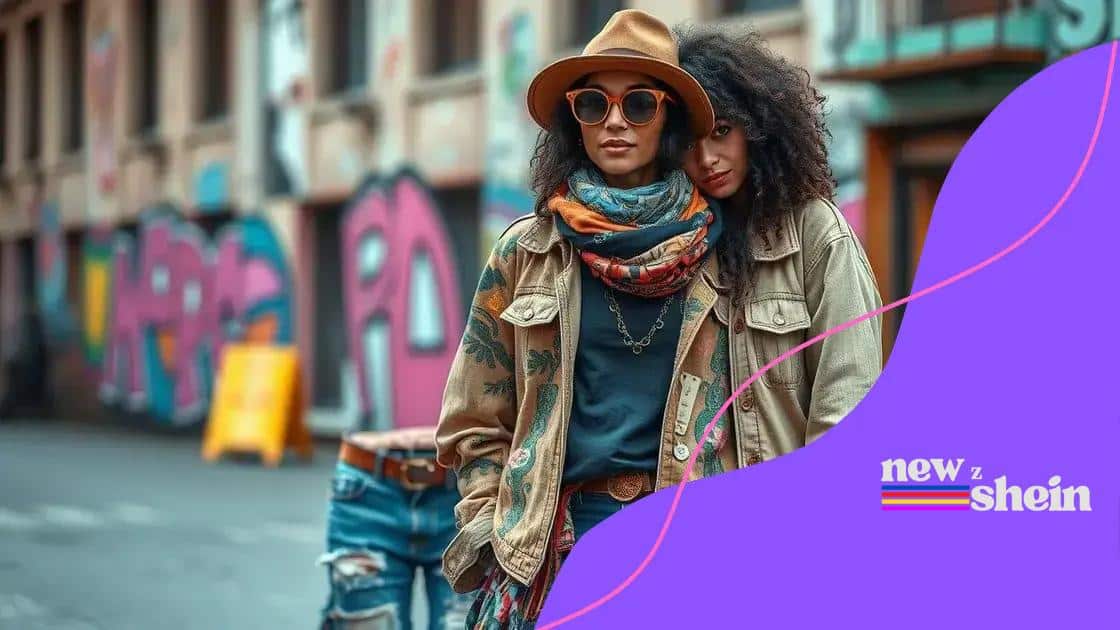Shein’s upcycling and DIY fashion guides to revamp your style

Shein’s upcycling and DIY fashion guides encourage you to creatively transform old clothing into unique, stylish pieces while promoting sustainability and individuality in your wardrobe.
Shein’s upcycling and DIY fashion guides bring a fresh perspective to your wardrobe. Have you ever thought about how reimagining your clothes can not only save money but also benefit the planet? Let’s dive into this exciting world!
Understanding upcycling in fashion
Understanding upcycling in fashion is crucial for anyone looking to make a positive impact on the environment. This practice not only helps reduce waste but also allows creativity to blossom. By transforming existing garments into unique pieces, you can express your personal style and contribute to sustainability.
What is Upcycling?
Upcycling refers to the process of taking used materials or items and repurposing them into something new and valuable. Unlike recycling, which often breaks down materials, upcycling gives new life to items without destroying their original form. This method encourages innovation and resourcefulness.
Benefits of Upcycling in Fashion
There are several advantages to embracing upcycling:
- It reduces textile waste in landfills.
- It minimizes the demand for fast fashion production.
- Upcycled items are often more unique and personal.
- It encourages creative problem-solving.
By upcycling, you not only make a fashion statement but also promote a sustainable lifestyle. It’s an excellent way to refresh your wardrobe without purchasing new items, all while being kinder to the planet.
In addition, upcycling often leads to higher quality and more durable garments. Many fast fashion pieces are designed for limited wear, leading to a cycle of buying and discarding. By focusing on upcycled items, you invest in fashion that has longevity. Moreover, each upcycled item carries a story, making it a special addition to your closet.
As you delve into upcycling, you will find that the possibilities are endless. From turning old jeans into a stylish bag to creating a new outfit from multiple garments, your creativity is the only limit. The best part is that the journey of creating something new from the old is incredibly rewarding.
Creative DIY projects with Shein
Creative DIY projects with Shein allow you to add a personal touch to your wardrobe while embracing sustainability. By using items from Shein, you can easily create fashionable pieces that express your unique style.
Getting Started with DIY
Before diving into your first project, gather your materials. Having a collection of basic tools and supplies will make the process smoother. Consider scissors, sewing kits, fabric glue, and embellishments to help bring your vision to life.
Project Ideas
Here are some fun and creative project ideas to inspire you:
- Transform an oversized T-shirt into a trendy crop top.
- Customize a plain denim jacket with patches and embroidery.
- Create a unique bag using old fabric scraps.
- Design a one-of-a-kind dress by combining two different pieces.
These projects are not only enjoyable but also provide a sense of accomplishment as you see your efforts come together. Each piece can be tailored to your preferences, making your wardrobe truly yours. The key is to experiment and not be afraid to make mistakes; that’s often where the best ideas come from.
Using Shein’s affordable and stylish items gives you the freedom to explore various DIY methods without breaking the bank. It encourages fashion enthusiasts to look at what they already own and think of ways to reinvent it. For example, adding some simple alterations to an existing piece can drastically change its look.
Additionally, you might want to host a DIY party with friends. Collaborating on projects can make the experience even more enjoyable. Sharing ideas and tips will inspire everyone, leading to a fun and creative atmosphere.
How to style upcycled clothing

How to style upcycled clothing is all about creativity and self-expression. Incorporating upcycled pieces into your wardrobe allows you to showcase your unique style while being eco-friendly. Here are some effective ways to wear and style your upcycled clothing.
Layering Techniques
Layering is a fantastic way to uplift any outfit. Pair a fitted upcycled top with an oversized vintage shirt for a relaxed look. By adding a chic jacket over your upcycled dress, you can easily transition from day to night. Layering not only enhances your outfit but also provides versatility.
Accessorizing
Accessories play a crucial role in styling:
- Jewelry: Add bold jewelry or handmade pieces to make your outfit pop.
- Bags: Choose unique bags made from upcycled materials for an interesting touch.
- Belts: Use belts to cinch dresses and tops, adding shape and style.
- Scarves: Incorporate colorful scarves for added flair.
Accessories can transform even the simplest outfits into fashionable statements. Experimenting with different items can lead to fresh combinations.
Don’t forget about the importance of shoes! Upcycled footwear or creative designs can compliment your outfit beautifully. Try pairing upcycled jeans with unique sneakers or boots to complete the look.
Playing with textures is another great way to style upcycled clothing. Mixing fabrics like denim, cotton, and lace creates a visually appealing ensemble. The contrast between textures can add depth to your outfit.
Another important aspect is color coordination. When styling your pieces, consider the colors that work well together. Using a color wheel can help guide your choices and create stylish combinations. Choose complementary colors to enhance the overall aesthetic.
Sustainable materials and their uses
Sustainable materials and their uses are essential in the world of fashion today. By choosing sustainable materials, we can reduce our environmental impact while promoting ethical production practices. These materials help create clothing that is both stylish and eco-friendly.
Types of Sustainable Materials
There are several sustainable materials available, each with unique properties that contribute to a greener wardrobe:
- Organic Cotton: Grown without harmful pesticides, organic cotton is soft, durable, and biodegradable.
- Bamboo Fabric: This material is eco-friendly, breathable, and has natural antibacterial properties.
- Recycled Polyester: Made from recycled plastic bottles, this material helps reduce waste and saves energy during production.
- Tencel: Constructed from sustainably sourced wood pulp, Tencel is biodegradable and incredibly soft.
These materials not only contribute to a healthier planet but also offer comfort and longevity in your wardrobe. As you explore these sustainable options, consider how each material fits into your style and needs.
Using sustainable materials encourages a more ethical approach to fashion. They often involve less water and energy in their production processes. Additionally, choosing clothes made from these materials supports companies that prioritize environmental responsibility.
Moreover, sustainable materials can also come from upcycled fabrics. By repurposing existing materials, we can significantly lessen our reliance on new resources. This practice not only reduces waste but also allows for innovative designs that stand out.
When shopping or crafting with sustainable materials, always check the labels and certifications. Understanding where your clothing comes from helps you make informed decisions about your purchases.
Tips for successful DIY transformations
Tips for successful DIY transformations can help you make the most of your upcycling projects. Whether you’re redesigning old clothes or creating something completely new, these tips will guide you toward achieving impressive results.
Planning Your Project
Before you start, take time to plan your project. Consider what items you want to transform and gather inspiration from various sources. Look for style guides online or browse social media for creative ideas. Developing a clear vision will make the process smoother and more enjoyable.
Gathering Materials
Having the right materials is crucial for a successful DIY project:
- Tools: Ensure you have essential tools like scissors, a sewing machine, and a hot glue gun.
- Fabrics and Embellishments: Collect various fabrics and decorations to personalize your pieces.
- Patterns: Consider using patterns for guidance, especially if you’re new to sewing.
Gathering your materials in advance allows you to work efficiently and keeps the process enjoyable.
As you begin your transformation, remember to take your time. Rushing through can lead to mistakes. Focus on each step, from cutting fabric to sewing pieces together. If you’re trying something new, don’t hesitate to practice first. Testing techniques on scrap materials can help build your confidence.
Additionally, be open to adjusting your plans. Sometimes, a change in direction can lead to an unexpectedly fantastic outcome. If a design isn’t turning out as you envisioned, allow yourself the freedom to explore new ideas.
Lastly, have fun and embrace the creative process. DIY transformations are all about personal expression, and each project is a chance to learn and grow. Celebrate your unique style and the creativity that comes from upcycling.
FAQ – Frequently Asked Questions about Upcycling and DIY Fashion
What is upcycling in fashion?
Upcycling in fashion involves transforming old or unused clothing into new, creative items, reducing waste and promoting sustainability.
How can I start my DIY transformation project?
Start by planning your project, gathering materials, and finding inspiration from online resources or communities.
What materials are best for upcycling?
Sustainable materials like organic cotton, recycled polyester, and old fabrics work great for upcycling projects.
Can I sell my upcycled creations?
Yes, many people sell their upcycled items online or at local markets, turning their creativity into a profitable venture.





